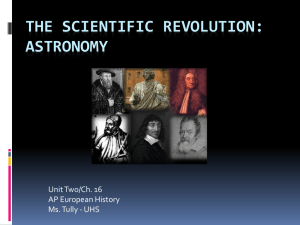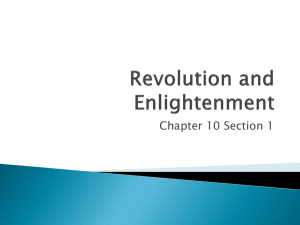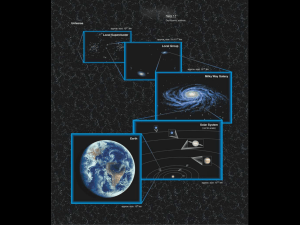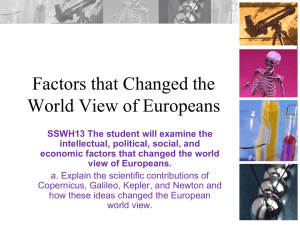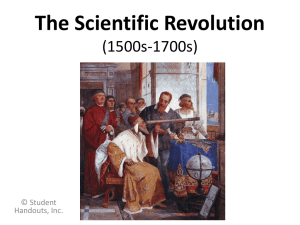Earth Science 22.1 Origins of Astronomy
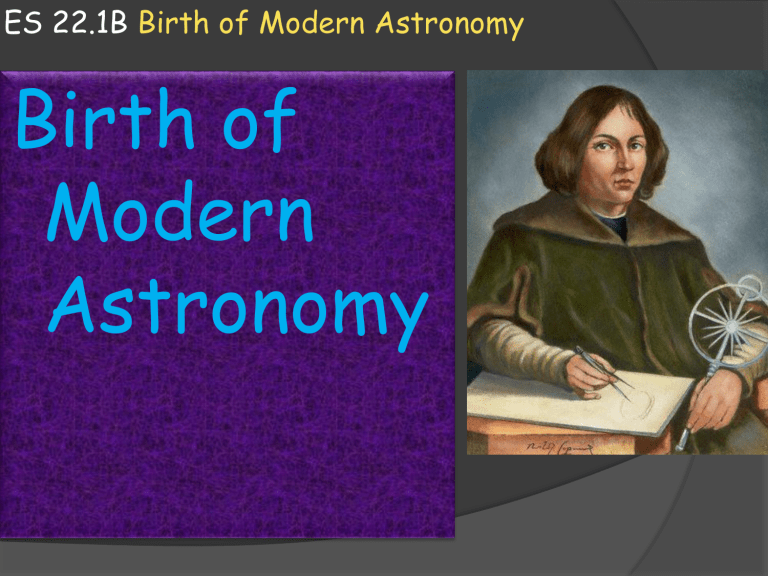
ES 22.1B Birth of Modern Astronomy
Birth of
Modern
Astronomy
Birth of Modern Astronomy
The development of modern astronomy involved a break from previous philosophical and religious views.
Scientists began to discover a universe governed by natural laws.
Five scientists are most noted for their development of our current views of our known universe
Nicolaus Copernicus
Tycho Brahe
Johannes Kepler
Galileo Galilei
Sir Isaac Netwon
Copernicus
Nicolaus Copernicus:
For almost 13 centuries after the time of Ptolemy, very few advances in astronomy were made in Europe.
The first great astronomer to emerge after the Middle Ages was
Nicolaus Copernicus (1473-1543) from Poland.
Copernicus became convinced that
Earth is a planet, just like the other five planets that were known.
To him, it made more sense that
Earth, rather than the entire sky, rotated once every day.
Copernicus
Nicolaus Copernicus:
Copernicus concluded that Earth is a planet . He proposed a model of the solar system with the sun at the center of it.
This was a major break from the idea that a motionless Earth lies at the center.
Copernicus used circles, which were considered to be the perfect geometric shape, to represent the orbits of the planets.
However, the planets seemed to stray from their predicted positions.
Copernicus
Tycho Brahe:
Tycho Brahe (1546-1601) was born of Danish nobility three years after the death of Copernicus.
Brahe became interested in astronomy while viewing a solar eclipse that had been predicted by astronomers.
He persuaded King Frederick II to build an observatory near
Copenhagen.
The telescope had not yet been invented.
Tycho Brahe:
At this observatory, Brahe designed and built instruments to measure movements of the planets and stars motions.
He used these instruments for 20 years to measure the locations of the heavenly bodies.
Brahe’s observations, especially of
Mars, were far more precise than any made previous to this.
In the last year of his life, Brahe found an able assistant named
Johannes Kepler.
Kepler kept most of Brahe’s observations and put them to further use advancing astronomy.
Tycho Brahe’s Observatory
Johannes Kepler:
Johannes Kepler (1571-1630) had a good mathematical mind and a strong belief in the accuracy of
Brahe’s work.
Kepler discovered three laws of planetary motion.
The first two laws resulted from his inability to fit Brahe’s observations of Mars into a circular orbit.
Johannes Kepler:
Kepler discovered that the orbit of
Mars around the sun is not a perfect circle.
Instead, it is an oval shaped path.
This oval is called an ellipse.
Two points inside the ellipse, each called a focus , help to determine the shape of the ellipse.
The farther apart the foci, the more stretched out the ellipse.
At the same time, Kepler discovered that the speed of Mars in it’s orbit changes in a predictable way.
As Mars approaches the sun, it speeds up . As it moves away, it slows down.
Elliptical orbit
Johannes Kepler:
Kepler summarized three laws of planetary motion.
Law 1:
The path of each planet around the sun is an ellipse, with the sun at one focus.
The other focus is symmetrically located at the opposite end of the ellipse.
Elliptical orbit
Johannes Kepler:
Law 2:
Each planet revolves so that an imaginary line connecting it to the sun sweeps over equal areas in equal time intervals.
If a planet is to sweep equal areas in the same amount of time, it must travel more rapidly when it is near the sun and more slowly when it is farther from the sun.
Elliptical orbit
Johannes Kepler:
Law 3:
The square of the length of time it takes a planet to orbit the sun (orbital period) is proportional to the cube of the average distance to the sun.
In it’s simplest form, the orbital period of revolution is measured in Earth years as a base.
The astronomical unit (AU) is the average distance between Earth and the sun.
This is about 150 million kilometers.
Galileo Galilei
Galileo Galilei (1564-1642) was the greatest scientist of the Italian
Renaissance.
Galileo’s most important contributions were his descriptions of the behaviors of moving objects.
All astronomical discoveries before his time were made without the aid of a telescope.
In 1609, Galileo heard that a Dutch lens maker had devised a system of lenses that magnified objects.
Galileo constructed his own telescope and used it to study the sky.
It magnified distant objects to three times the size seen by the unaided eye.
Galileo’s first telescope
Galileo Galilei’s Discoveries
Using this first telescope, Galileo was able to view the universe in a new way. He made many important discoveries that supported Copernicus’s view of the universe.
1: The discovery of four satellites, or moons, orbiting Jupiter.
This proved the old idea of Earth being the only center of motion in the universe was wrong. Here plainly visible was another center of motion, Jupiter.
People who opposed the sun-centered system of the universe said that the moon would be left behind if the Earth really revolved around the sun. Galileo’s discovery disproved this argument.
Jupiter’s moons
Galileo Galilei
2: The discovery that the planets are circular discs, not just points of light, as was previously thought. This showed that the planets were not stars.
3: The discovery that Venus has phases, just like the moon.
Venus orbits it’s source of light, the sun . Galileo saw that
Venus appears smallest when it is in full phase and therefore farthest from
Earth.
Phases
Venus from
Earth
Galileo Galilei
4: The discovery that the moon’s surface was not smooth. Galileo saw mountains and craters and plains. Before Galileo, people that all objects in the sky were perfect and smooth.
5: The discovery that the sun had sunspots, or dark regions.
These blemishes showed that the sun was not perfect. Galileo tracked the movement of these spots and estimated the rotational period of the sun as just under one month.
Sir Isaac Newton
Sir Isaac Newton (1642-1727) was born in the year of Galileo’s death.
Many scientists had attempted to explain the forces involved in planetary motion. Kepler believed that some force pushed the planets along their orbits.
Galileo correctly reasoned that no force is required to keep an object in motion.
Galileo also proposed that a moving object will continue to move in a straight line. This concept is called inertia.
Sir Isaac Newton
The problem than was not to explain the force that keeps the planets moving but rather to determine the force that keeps them from going in a straight line out into space.
Newton was the first to describe a force that holds the moon in an orbit around the Earth, gravity .
Although others had theorized the existence of such a force, Newton was the first to formulate and test the law of universal gravitation.
Sir Isaac Newton: Universal Gravitation
Universal Gravitation:
According to Newton, every body in the universe attracts every other body with a force that is directly proportional to their masses – and inversely proportional to the square of the distance between their centers of mass.
The mass of an object is a measure of the total amount of matter it contains.
Sir Isaac Newton: Universal Gravitation
Universal Gravitation:
The gravitational force decreases with distance, so that two objects three kilometers apart have 9 times
(3 squared) less gravitational attraction than if the same objects were only 1 kilometer apart.
The law of Universal Gravitation also states that the greater the mass of an object, the greater it’s gravitational force.
For example, the mass of the moon creates a gravitational force strong enough to cause ocean tides on
Earth. But the tiny mass of the satellite moon has no effect on the main body of the Earth itself.
Pull of moon and sun on
Earth producing tides
Sir Isaac Newton: Universal Gravitation
Universal Gravitation:
Newton proved that the force of gravity, combined with the tendency of the planet to remain in straight-line motion, results in the elliptical orbit that Kepler discovered.
Earth, for example, moves about 30 kilometers each second in it’s orbit.
During the same second, the force of gravity pulls it toward the sun about 0.5 of a centimeter.
Sir Isaac Newton: Universal Gravitation
Newton concluded that it is a combination of the earth forward motion and it’s
“falling” motion that defines it’s orbit.
If gravity were somehow eliminated, Earth would instead move in a straight line out into space away from the sun.
If Earth’s forward motion suddenly stopped, gravity would pull it directly toward the sun.
Sir Isaac Newton: Universal Gravitation
Newton used the law of universal gravitation to redefine Kepler’s third law, which states the relationship between the orbital periods of the planets and their solar distances.
When restated, Kepler’s third law takes into account the masses of the body when the orbit of one of the satellites is known.
Earth Science 22.1 Origins of Astronomy
.

